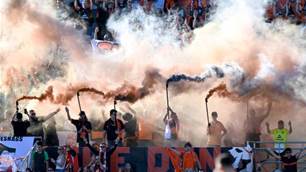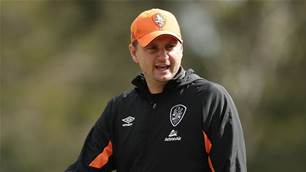THE fall of the former North Queensland Fury players...
The demise of fledging A-League side North Queensland Fury impacted more than many imagined. Former Fury defender-turned-journalist Beau Busch reveals that for many players, it resulted in the end of their careers...
Bill Shankly may have been extreme when he said “they say Football’s a matter of life and death – but it’s more important than that,” however for many former North Queensland Fury players the death of their club has resulted in a very different life.
On 1 March 2011, FFA announced it was no longer willing to continue to fund the Fury and the club would fold with immediate effect. FFA CEO Ben Buckley stated that the Fury had been unable to raise the $1.5 million required to ensure its survival, and they were no longer willing to keep funding the club at the expense of the league. After a difficult season for the A-League competition Buckley said: “We need to concentrate our resources on the growth, promotion and stability of the entire A-League competition and this level of investment would prevent us from undertaking programs to achieve this.”
Whilst the wisdom of the decision can be debated, the effect it has had on many of the Fury’s former playing squad is clear. For the majority of the 23 players signed on full-time contracts throughout the 2010-2011 season their lives have changed dramatically. Seven were able to move to new A-League clubs to continue their careers. Some are now plying their trade in Asia, lower European leagues or state leagues, and some are no longer playing at all. Simon Storey and Dyron Daal are playing in Asia, while imports Mark Hughes, Andre Killian and Eugene Sspeuya have returned to play in Europe after their season in the A-League. The remaining 12 of the Fury’s 23-man squad have not had the same opportunity to continue their careers as professional footballers. For four of them football is no longer an option and they have retired from the sport, whilst the remaining eight seek an avenue back into professional football.
With opportunities in the A-League limited, seven returned to state league competitions across the country in the hope of attracting the attention of A-League or Asian clubs, while import Eric Akoto returned to the United Kingdom where he has been unable to secure a new club.
One of the eight players desperately trying to get back into full-time football, Chris Grossman, says the chances of getting into another A-League club were always likely to be slim. “The Fury died without a lot of warning and there weren’t many leagues open at the time. Options in the A-League were tough as most teams already had their rosters pretty much full,” he says.
Grossman, who is now trying to secure a club in Asia, says the decision is still affecting him now and he has found it extremely difficult to move on after the death of the Fury. “It was a massive let down. I’m still hurting from it now. You work so hard to achieve things in the game and it just feels like it was all taken away. I had come from the Roar, where I wasn’t getting to play much, to the Fury where I played regularly and I felt like I was only just getting where I wanted.”
Moves to Asia have fallen through just as they were close to being agreed in what has seemed like a constant waiting game for the midfielder. “I am hopeful of getting back playing, you go through a lot of things and speak to agents and you have leads but they can fall over so quickly, which has been hard.”
Like Grossman, Panni Nikas was hopeful of a swift return to professional football, but so far this has not eventuated. The former National Youth League Player of the Year, returned to the NSW Premier League after the demise of the Fury. Since his return to Sydney he has thrown himself into his studies and has had a successful season, with his team Sutherland finishing third in the NSWPL, but he is unsure of his next move.
“I am not up to anything football-wise at the moment. The state league season is over, I am trying to squeeze something out but I’m not sure whether anything will come up, so I’ve been concentrating on my studies.” While he has been eager to move on from the Fury, Nikas says it has not been easy. “I probably didn’t understand what impact it would have on mine and other peoples’ lives, especially the older boys with families. I just thought everything was going to be alright, but two to three months later I think about the effect it has had on them, and it has been difficult.”
For former Fury attacker Jason Spagnuolo the death of the Fury signalled the end of his time as a professional footballer. After what he described as a difficult two seasons with the Fury, Spagnuolo decided it was time to move into a new field. Now working as a real estate agent back in his home city of Adelaide, Spagnuolo says the uncertainty that had surrounded the club had made his time in North Queensland difficult. “I really enjoyed Townsville but the football was never good to be honest, it was a battle on the pitch and off it. After the difficult times up there I am really enjoying just working, it is structured and I am happy to be in this type of environment.”
Continues on next page...
Like Spagnuolo, the demise of the Fury has marked the end of Gareth Edds’ football career. Having rejected approaches from rival A-league clubs during the 2010-2011 season Edds was eager to remain at the Fury after returning to Australia from England with his family. “I didn’t expect it to happen. I could have stayed in England but I chose to come back expecting to extend my career, unfortunately it worked out the other way.”
Unable to find another A-league club immediately after the demise of the Fury, Edds says it has been an extremely difficult period. “We always had hope it was going to hang around [the Fury]. The feeling you get when someone turns around and says that is it, the club is closed... you are left in a position where you are lost.
“It was so difficult – you are used to playing. Throughout my career in England I didn’t stop. You are always thinking about how you can make yourself better, then suddenly you have to work out how you are going to survive. How am I going to keep my family going?”
Far from turning his back on the game, Edds opted to stay in Townsville and establish his own football academy – the Gareth Edds Soccer Academy. Edds says he had always planned to move into coaching after his playing days were over, but had not planned for it to be so sudden. Thoroughly enjoying his new career, Edds says he feels most for the younger members of the Fury squad who have so far been unable to find new clubs. “For some it was their first experience in the A-League. At the end of the day I have played a lot of games. I have had a career. Some of these kids haven’t had a chance to start their career.”
Like Edds, North Queensland product Matt Ham decided to hang up his boots and pursue a new career after the demise of the Fury. The goalkeeper is pursuing a career in Sports Science and after much soul searching is now undertaking a Masters. “When the decision came to pan us, it kind of took all the motivation and wind out of my sails to get back into football,” says Ham. “I had to look at what the hell I was going to do and I decided to do my Masters. As I thought my playing days were over it was the next best thing to be involved with athletes to train them. Trust me, it was a very hard decision and it has taken me a while to get my head around not playing footy and knuckling down and studying.”
Ham says the season had many difficulties both personally and as a club. Having seen serious injuries ruin his previous spell in the A-League with Brisbane Roar, the Fury was the second chance he had been seeking. However, injury struck again and his season was ruined when he sustained a serious knee injury at training. “The uncertainty over the future of the club played havoc on all of us. We had futures to secure; some boys had families. It was tough to be involved in,” adds Ham.
Teammate Nikas agrees that the insecurity surrounding the club affected performances on the pitch. “In the last few months guys were turning up and you could see their minds weren’t on training. It was like ‘does anyone have any news on the Fury and what is happening?’,” says Nikas. “It was difficult but maybe if we had played a bit better and things were on our side, and say, we came fifth, maybe it would have pushed the FFA not to kick us out.”
Ham says that other factors besides the uncertainty surrounding the club had a major impact on the Fury’s performances. Chief among these was Coach Franz Straka. “The coach was very poor,” he says. This may come as a shock for some fans considering how popular Straka was at the Fury. “He had a great affinity with the supporters but I believe he lost the dressing room quite early in the season with his poor tactics, training sessions and treatment of players, especially the young ones.”
Ham says he is not one to criticise coaches just because he may disagree with them, but feels Straka had such a negative influence on the playing squad it was impossible for it not to impact on performances.
“He singled out players for his failings as a coach and his dictator mentality stopped other coaches and staff from doing their jobs. For instance, our pre-season was taken out of our strength coach’s hands – doing weird resistance circuits and swimming and other weird things,” adds Ham. “Our injuries were deemed not serious enough when the physios thought otherwise and sometimes we were punished for being injured.”
Teammate Adam Casey agrees with Ham’s assessment of Straka and says the public perception of the Czech coach was very different to the reality. “Franz was good for the fans but his strategies didn’t help us at all. We weren’t coached well and many of the decisions he made on tactics and training sessions were very weird.”
Continues on next page...
Now looking to regain full fitness, after a short stint in the Illawarra Premier League, Casey says he’s aiming to get back into playing full-time. However, the former Sydney FC attacker says he needs to concentrate first on getting past the niggling injuries that have affected him over the past few seasons.
“I just want to get my body right; I have been struggling with injuries on and off for a while and I need to get the confidence in my body back,” says Casey. “I don’t think the A-League is out of the question for me, I am only 25, but my main priority is to look after my young daughter and do what is right by my family.”
Many of the players say a move back to the A-League or into other professional leagues could have been made easier had FFA kept them informed regarding the likelihood of the club surviving. Grossman says the players were totally in the dark, with most trying to keep positive about the club’s survival prospects throughout the season. “We never heard anything from FFA. The only indications we heard from FFA were what we heard through the papers,” says Grossman. “The only news we got was from the PFA [Professional Footballers Association] the day before [FFA announced the club would fold] saying there was a press conference being held in Townsville the next day and they were 99 per cent sure the Fury was going to be gone.”
Grossman says this made things more difficult as other options were put on hold as most players’ preference was to remain at the Fury. “The majority of people who were up in North Queensland wanted to help the club succeed and wanted to stay for the long term, so you didn’t really want to look at other places. If they had given us a heads-up it would have helped a lot of people avoid this situation.” With a lack of information from the governing body, Grossman says the players were reliant on information coming from the club itself. Desperate to continue into the future, Grossman said the club was doing everything in its power to survive and was therefore confident of remaining in the A-League. “Rabieh [Krayem, Fury CEO] was coming in and saying we are going to be here next year and he was extremely positive,” says Grossman.
Ham says FFA failed to take into account the difficulty players faced in finding a new club whilst not being in the shop window of the A-League, and should have kept the players more informed. “We could have made plans for our future much earlier and maybe secured another gig somewhere with the backing as a pro footballer instead of looking for a club as a non-professional,” he says.
Former Fury defender Brett Studman agrees, saying FFA should have taken into account the need for players to get their playing futures sorted as early as possible. “It was rubbish, the way everything was dealt with. You realised they had no intention of keeping the club afloat.”
Studman is now exploring options in Asia after starring in the NSW Premier League for Sydney Olympic. He says FFA was not aware of the impact its decision would have on the lives of the players. “It is really tough to get back into the A-League now as there are fewer opportunities. You have to go overseas and try to make a living there.”
Whilst the demise of the Fury had a major impact on all the lives of its ex-players, they were all equally concerned with the effect it would have on the region. With no professional football team within 1,300 kilometres of Townsville it is highly likely a generation of talented young players will be lost to rival codes such as Rugby League which can provide a pathway to the top level in Australia.
Having grown up in North Queensland, Ham knows better than most what effect the Fury’s demise will have on the sport in the region. “I know how dominant Rugby League is in the area. Finally we were making inroads with football up there and it has been taken back 20 or 30 years due to the decision,” says Ham. “If you kick these supporters in the guts enough they will turn away from the game forever and not look back, unfortunately FFA have done that and I think professional football in the north is dead.”
Having stayed behind in Townsville after the end of the Fury to play for Queensland State League club the North Queensland Razorbacks, Grossman says a difference in the locals’ appetite for the sport was already noticeable. “The level of enthusiasm in the kids up there dropped massively as they no longer have anything to aim towards,” says Grossman.
Trying to provide a pathway through his academy in Townsville, Gareth Edds says there is still enthusiasm for the sport, but few speak of the A-League. “I have kids that come to my academy that wouldn’t wear a Fury shirt because they don’t want to hurt my feelings and to be honest there is not much talk about the A-League. No kids ever come in and say did you see this? Did you see that?”
With people like Edds committed to football in North Queensland the game may live on. However, for many ex-Fury players and fans the death of their club ended their association with football and the game is no longer the same, and unfortunately neither are their lives. Football is not a matter of life or death but the Fury’s demise shows that life without it can be far from easy.
This article appeared in the February 2012 issue of Australian FourFourTwo magazine. To buy back copies of this issue call 03-8317-8121 with a credit card to hand.
The current edition of Australian FourFourTwo has just gone on sale in newsagent across the country, or you can subscribe here
Related Articles

A new era is unfolding at Brisbane Roar

Brisbane coach slams 'one rule for us, one rule for AFL, NRL'













